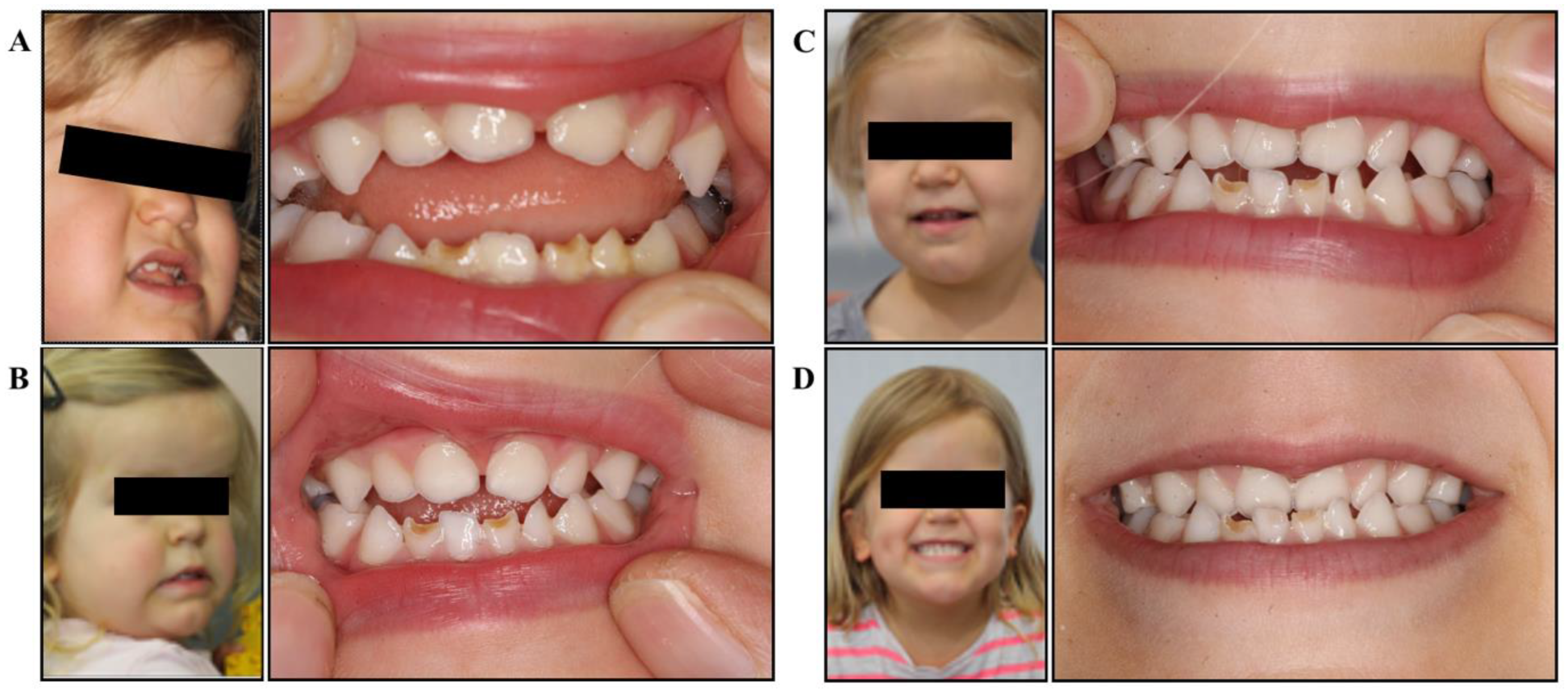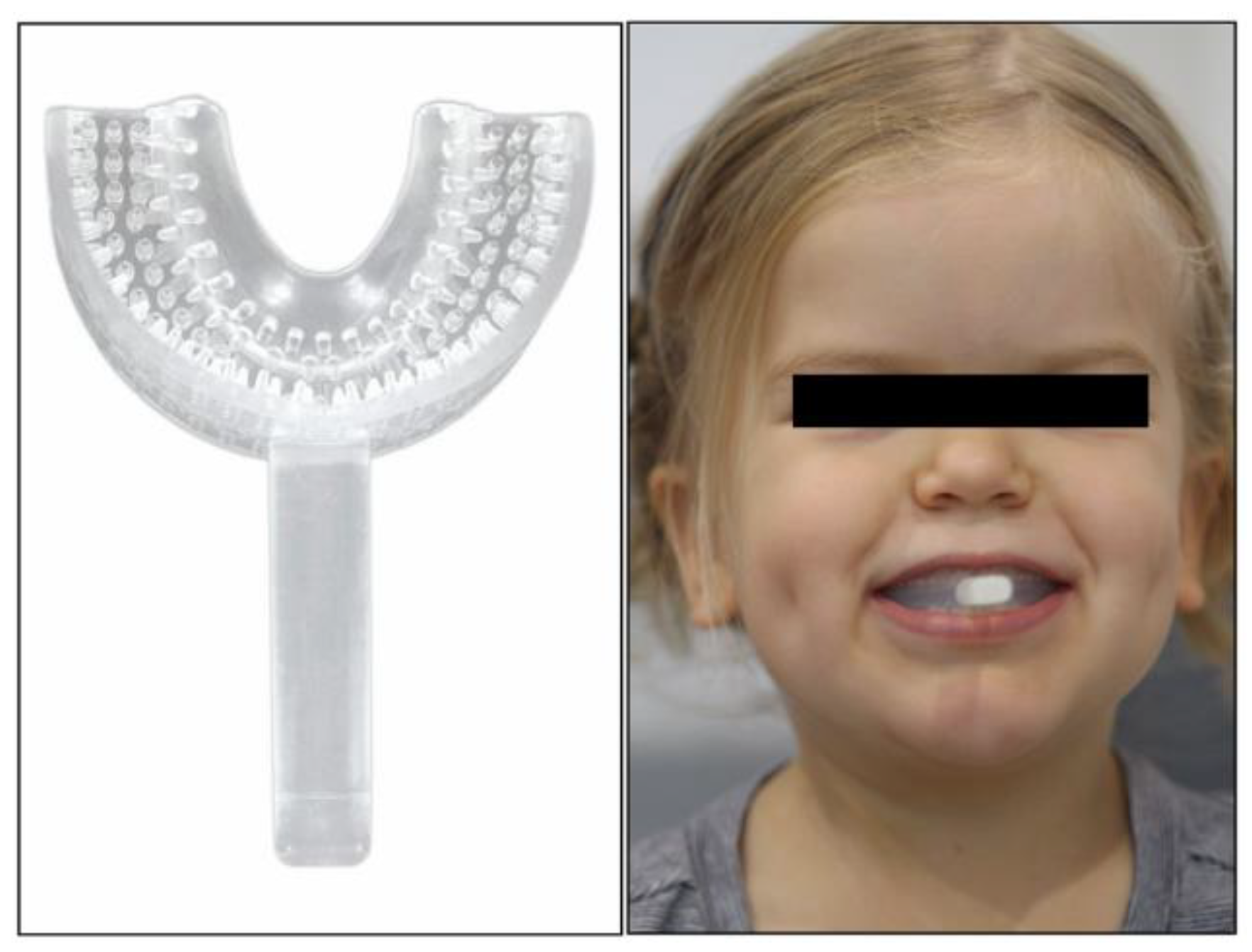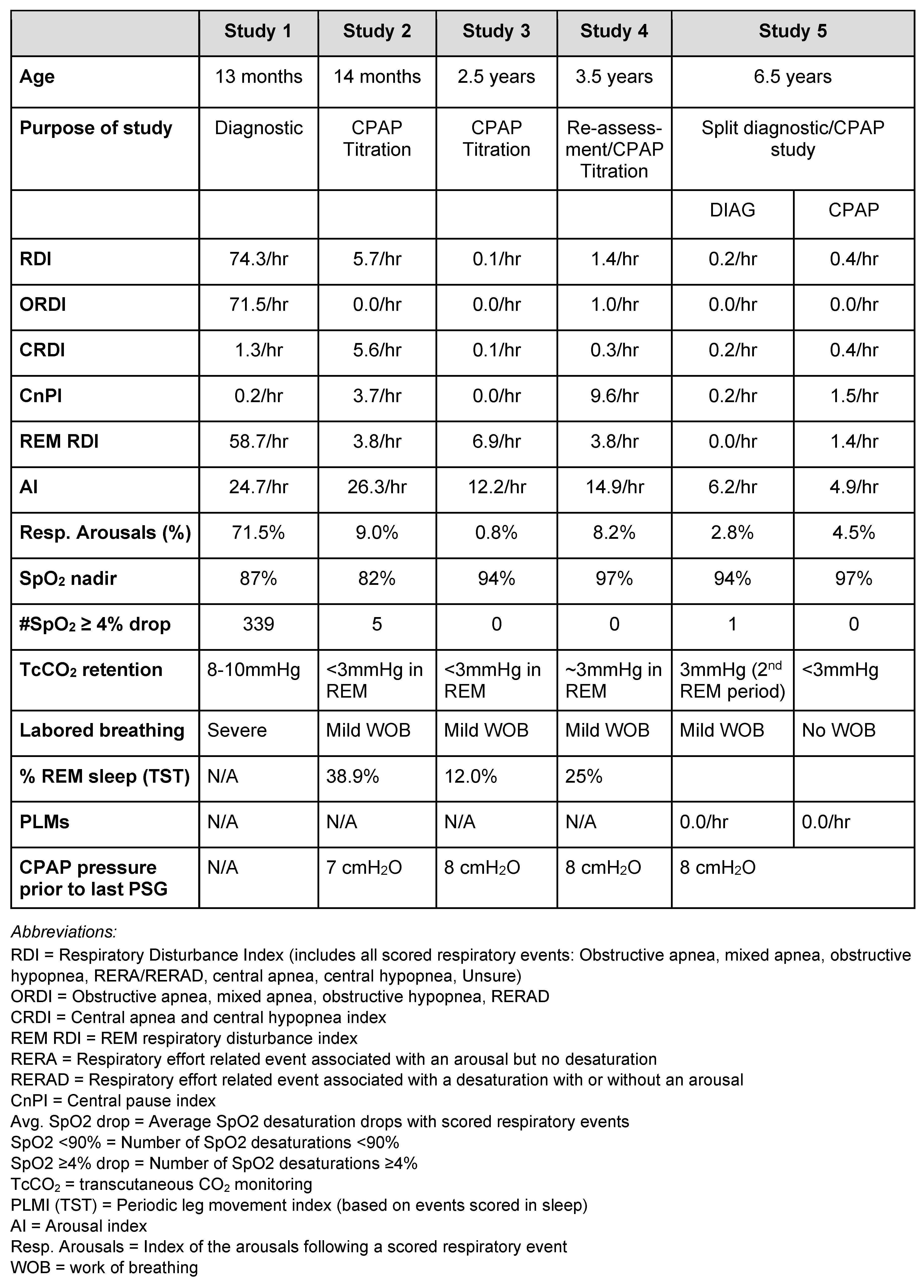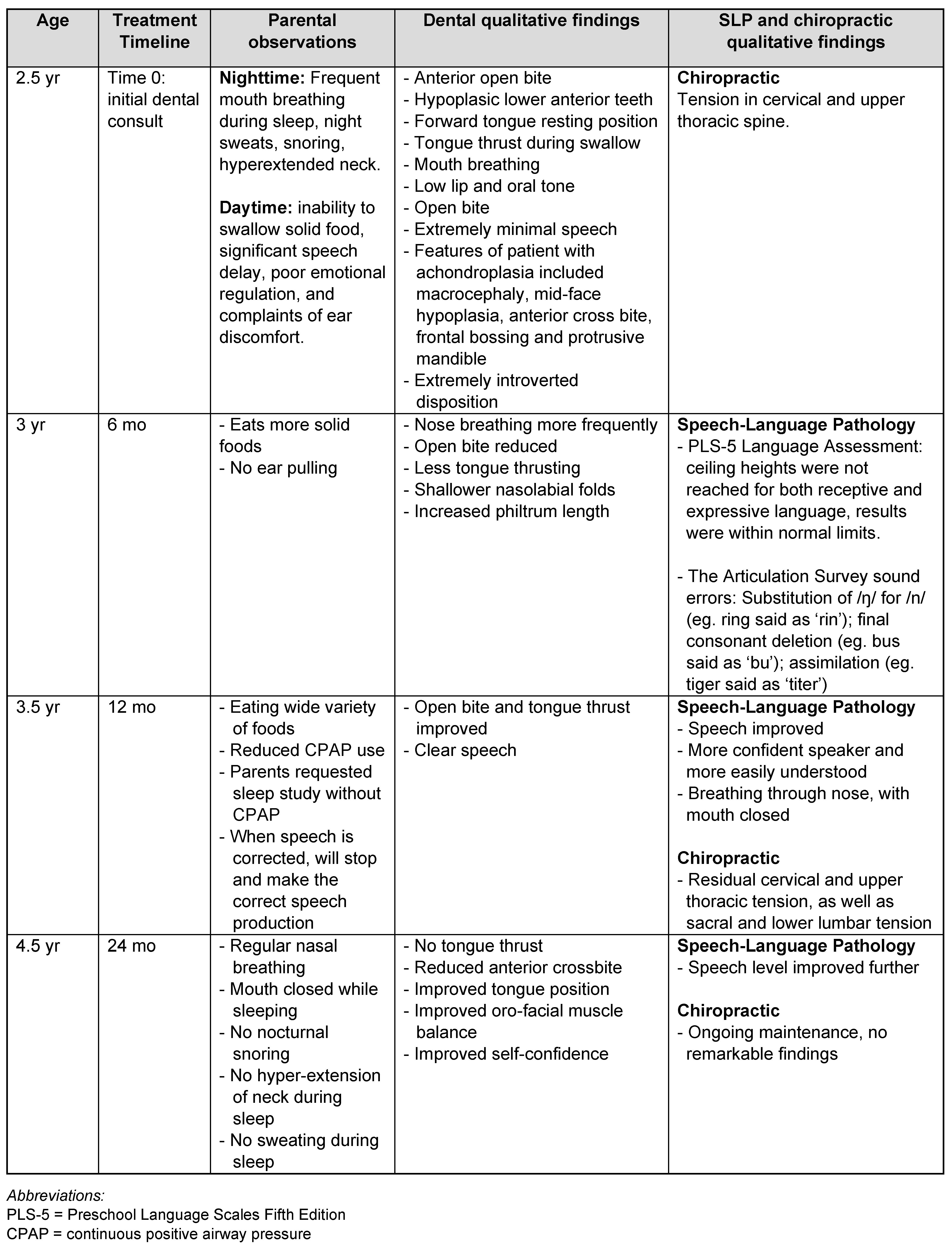A Myofunctional Chewing Device as an Early Intervention Tool for a Child with Achondroplasia and Obstructive Sleep Apnea
Abstract
INTRODUCTION
Patient Information
Clinical Presentation
- Anterior open bite
- Hypoplasic lower anterior teeth
- Forward tongue rest position and tongue thrust on swallow
- Mouth breathing
- Poor lip and oral tone
- Open bite
- Borderline non-verbal with extremely minimal speech. Parents needed to interpret the sounds the patient made and communicate this to the practitioner
- Typical features of patient with achondroplasia including macrocephaly, mid-face hypoplasia, anterior cross bite, frontal bossing, and protrusive mandible
- Extremely introverted disposition
- Patient chewed pacifier
Assessments and Therapeutic Intervention
- Replace pacifier with Myo Munchee chewing.
- Myo Munchee chewing: Block practice of chewing twice per day, building to 10 minutes of active use each session.
- Tongue exercises: repeat each exercise 10 times 2x per day.
- Make /n/ sound by placing tongue tip at incisive papilla.
- Perform tongue clicks with tongue tip at the incisive papilla.
- The Myo Munchee size was changed at 18 months from a “Mini” size to a “Small” size. There was no change to the rest of this protocol.
- Progress was evaluated every 6 months during follow-up appointments, and treatment was modified as necessary.
- Adherence was assessed when the patient visited the clinic. Patient was highly adherent as witnessed by parents and dentist. She did not require any extrinsic motivators to complete treatments.
- Chiropractic
- Assessments: pelvic and spinal assessments
- Treatment: low force technique and ArthostimTM instrument adjustment of spine and pelvis, and extremity mobilization.
- Timeline: initiated within the first month of life
- Frequency of appointments: every 3-4 weeks.
- Speech-language pathology
- Assessments:
- Preschool Language Scales Fifth Edition (PLS-5) (Zimmerman et al., 2002)
- The Articulation Survey (Atkin & Fisher, 1996)
- Treatment: rounding of lips for /ʃ/ (“sh”), adding word-final consonants, improve contact of lips to ensure bilabial production, encourage speaking and engagement with others
- Timeline: received care over 24-month period
- Frequency of appointments: every 2-4 weeks
Results and Outcomes
Parents’ perspectives
Discussion
Limitations and Future Studies
Conclusion
Author Contributions
Funding
Data Availability Statement
Acknowledgments
Consent to Participate
Conflicts of Interest
References
- Atkin, M., and J. Fisher. 1996. Articulation Assessment survey—Articulation survey. Melbourne: Royal Children’s Hospital. [Google Scholar]
- Benkert, K. 1997. The effectiveness of orofacial myofunctional therapy in improving dental occlusion. International Journal of Orofacial Myology 23, 1: 35–46. [Google Scholar] [CrossRef]
- Bernkopf, E., G. Cristalli, G. C. de Vincentiis, G. Bernkopf, and V. Capriotti. 2022. Temporomandibular Joint and Otitis Media: A Narrative Review of Implications in Etiopathogenesis and Treatment. Medicina 58, 12: 1806. [Google Scholar] [CrossRef]
- Camacho, M., V. Certal, J. Abdullatif, S. Zaghi, C. M. Ruoff, R. Capasso, and C. A. Kushida. 2015. Myofunctional Therapy to Treat Obstructive Sleep Apnea: A Systematic Review and Meta-analysis. Sleep 38, 5: 669–675. [Google Scholar] [CrossRef]
- Cao, M. T., J. M. Sternbach, and C. Guilleminault. 2017. Continuous positive airway pressure therapy in obstuctive sleep apnea: benefits and alternatives. Expert Review of Respiratory Medicine 11, 4: 259–272. [Google Scholar] [CrossRef] [PubMed]
- Chhabra, N., A. Chhabra, and R. Mehta. 2016. Craniofacial manifestations and dental considerations in association with achondroplasia: Clinical insight and report of a case. SRM Journal of Research in Dental Sciences 7, 4: 264. [Google Scholar] [CrossRef]
- Chuang, L.-C., Y.-J. Hwang, Y.-C. Lian, M. Hervy-Auboiron, P. Pirelli, Y.-S. Huang, and C. Guilleminault. 2019. Changes in craniofacial and airway morphology as well as quality of life after passive myofunctional therapy in children with obstructive sleep apnea: a comparative cohort study. Sleep and Breathing 23, 4: 1359–1369. [Google Scholar] [CrossRef] [PubMed]
- Chwieśko-Minarowska, S., Ł. Minarowski, A. Kuryliszyn-Moskal, J. Chwieśko, and E. Chyczewska. 2013. Rehabilitation of patients with obstructive sleep apnea syndrome. International Journal of Rehabilitation Research. Internationale Zeitschrift Fur Rehabilitationsforschung. Revue Internationale de Recherches de Readaptation 36, 4: 291–297. [Google Scholar] [CrossRef]
- De Dios, J. A. A., and S. D. Brass. 2012. New and Unconventional Treatments for Obstructive Sleep Apnea. Neurotherapeutics 9, 4: 702–709. [Google Scholar] [CrossRef]
- Gay, P., T. Weaver, D. Loube, and C. Iber. 2006. Evaluation of Positive Airway Pressure Treatment for Sleep Related Breathing Disorders in Adults. Sleep 29, 3: 381–401. [Google Scholar] [CrossRef]
- Guimarães, K. C., L. F. Drager, P. R. Genta, B. F. Marcondes, and G. Lorenzi-Filho. 2009. Effects of Oropharyngeal Exercises on Patients with Moderate Obstructive Sleep Apnea Syndrome. American Journal of Respiratory and Critical Care Medicine 179, 10: 962–966. [Google Scholar] [CrossRef]
- Hopper, D. E., and G. Cramer. 2023. Conservative Treatment Using Chiropractic Care and Orofacial Myofunctional Therapy for Obstructive Sleep Apnea: A Case Report. Journal of Chiropractic Medicine 22, 3. [Google Scholar] [CrossRef]
- Hunter, A. G., A. Bankier, J. G. Rogers, D. Sillence, and C. I. Scott. 1998. Medical complications of achondroplasia: a multicentre patient review. Journal of Medical Genetics 35, 9: 705–712. [Google Scholar] [CrossRef]
- Koka, V., A. De Vito, G. Roisman, M. Petitjean, G. R. Filograna Pignatelli, D. Padovani, and W. Randerath. 2021. Orofacial Myofunctional Therapy in Obstructive Sleep Apnea Syndrome: A Pathophysiological Perspective. Medicina 57, 4: 323. [Google Scholar] [CrossRef] [PubMed]
- Kopits, S. E. 1988. Thoracolumbar Kyphosis and Lumbosacral Hyperlordosis in Achondroplastic Children. Springer EBooks: pp. 241–255. [Google Scholar] [CrossRef]
- Li, K. K., R. W. Riley, and C. Guilleminault. 2000. An Unreported Risk in the Use of Home Nasal Continuous Positive Airway Pressure and Home Nasal Ventilation in Children. Chest 117, 3: 916–918. [Google Scholar] [CrossRef]
- Pineau, M., E. Farrow, R. Nicot, and J. Ferri. 2018. Achondroplasia. Journal of Craniofacial Surgery 29, 8: 2186–2191. [Google Scholar] [CrossRef] [PubMed]
- Rohilla, S., A. Kaushik, V. C. Vinod, R. Tanwar, and M. Kumar. 2012. Orofacial manifestations of achondroplasia. EXCLI Journal 11: 538–542. Available online: https://www.ncbi.nlm.nih.gov/pmc/ articles/PMC4897656/.
- Rosenfeld, R. M., J. J. Shin, S. R. Schwartz, R. Coggins, L. Gagnon, J. M. Hackell, D. Hoelting, L. L. Hunter, A. W. Kummer, S. C. Payne, D. S. Poe, M. Veling, P. M. Vila, S. A. Walsh, and M. D. Corrigan. 2016. Clinical Practice Guideline. Otolaryngology–Head and Neck Surgery 154, 2: 201–214. [Google Scholar] [CrossRef]
- Savarirayan, R., P. Ireland, M. Irving, D. Thompson, I. Alves, W. A. R. Baratela, J. Betts, M. B. Bober, S. Boero, J. Briddell, J. Campbell, P. M. Campeau, P. Carl-Innig, M. S. Cheung, M. Cobourne, V. Cormier-Daire, M. Deladure-Molla, M. del Pino, H. Elphick, and V. Fano. 2021. International Consensus Statement on the diagnosis, multidisciplinary management and lifelong care of individuals with achondroplasia. Nature Reviews Endocrinology 18, 3: 1–17. [Google Scholar] [CrossRef]
- Serel Arslan, S., N. Demir, and A. A. Karaduman. 2016. Effect of a new treatment protocol called Functional Chewing Training on chewing function in children with cerebral palsy: a double-blind randomised controlled trial. Journal of Oral Rehabilitation 44, 1: 43–50. [Google Scholar] [CrossRef]
- Valbuza, J. S., M. M. de Oliveira, C. F. Conti, L. B. F. Prado, L. B. C. de Carvalho, and G. F. do Prado. 2010. Methods for increasing upper airway muscle tonus in treating obstructive sleep apnea: systematic review. Sleep and Breathing 14, 4: 299–305. [Google Scholar] [CrossRef]
- Villa, M. P., L. Brasili, A. Ferretti, O. Vitelli, J. Rabasco, A. R. Mazzotta, N. Pietropaoli, and S. Martella. 2014. Oropharyngeal exercises to reduce symptoms of OSA after AT. Sleep and Breathing 19, 1: 281–289. [Google Scholar] [CrossRef] [PubMed]
- Villa, M. P., J. Pagani, R. Ambrosio, R. Ronchetti, and E. Bernkopf. 2002. Mid-face hypoplasia after long-term nasal ventilation. American Journal of Respiratory and Critical Care Medicine 166, 8: 1142–1143. [Google Scholar] [CrossRef] [PubMed]
- Zimmerman, I. L., V. G. Steiner, and R. E. Pond. 2002. Preschool Language Scale, Fourth Edition. PsycTESTS Dataset. [Google Scholar] [CrossRef]


 |
 |
© 2024 by the authors. 2024 Donny Mandrawa, Mary Bourke, Ignatius Bourke.
Share and Cite
Mandrawa, D.; Bourke, M.; Bourke, I. A Myofunctional Chewing Device as an Early Intervention Tool for a Child with Achondroplasia and Obstructive Sleep Apnea. Int. J. Orofac. Myol. Myofunct. Ther. 2024, 50, 1-8. https://doi.org/10.52010/ijom.2024.50.1.2
Mandrawa D, Bourke M, Bourke I. A Myofunctional Chewing Device as an Early Intervention Tool for a Child with Achondroplasia and Obstructive Sleep Apnea. International Journal of Orofacial Myology and Myofunctional Therapy. 2024; 50(1):1-8. https://doi.org/10.52010/ijom.2024.50.1.2
Chicago/Turabian StyleMandrawa, Donny, Mary Bourke, and Ignatius Bourke. 2024. "A Myofunctional Chewing Device as an Early Intervention Tool for a Child with Achondroplasia and Obstructive Sleep Apnea" International Journal of Orofacial Myology and Myofunctional Therapy 50, no. 1: 1-8. https://doi.org/10.52010/ijom.2024.50.1.2
APA StyleMandrawa, D., Bourke, M., & Bourke, I. (2024). A Myofunctional Chewing Device as an Early Intervention Tool for a Child with Achondroplasia and Obstructive Sleep Apnea. International Journal of Orofacial Myology and Myofunctional Therapy, 50(1), 1-8. https://doi.org/10.52010/ijom.2024.50.1.2




